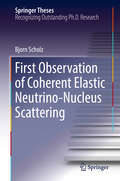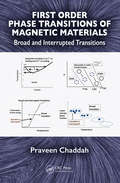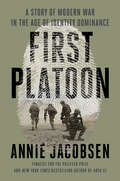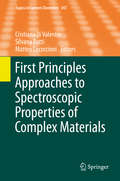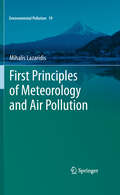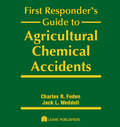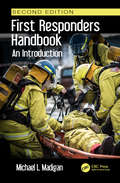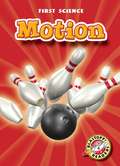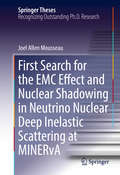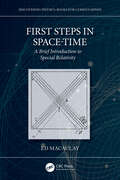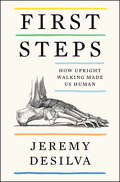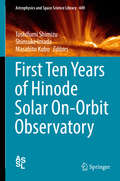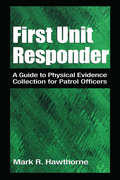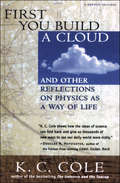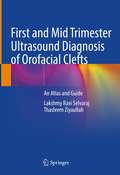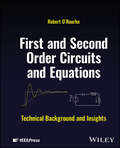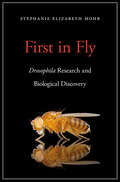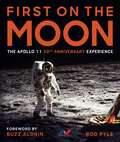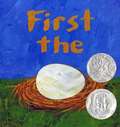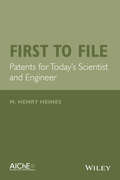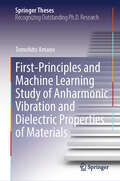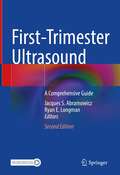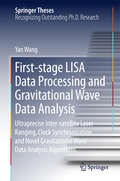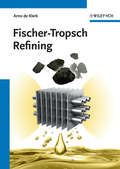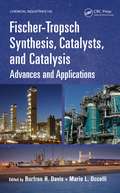- Table View
- List View
First Observation of Coherent Elastic Neutrino-Nucleus Scattering (Springer Theses)
by Bjorn ScholzThis thesis describes the experimental work that finally led to a successful measurement of coherent elastic neutrino-nucleus scattering—a process proposed forty-three years ago. The experiment was performed at the Spallation Neutron Source facility, sited at Oak Ridge National Laboratory, in Tennessee.Of all known particles, neutrinos distinguish themselves for being the hardest to detect, typically requiring large multi-ton devices for the job. The process measured here involves the difficult detection of very weak signals arising from nuclear recoils (tiny neutrino-induced “kicks” to atomic nuclei), but leads to a much larger probability of neutrino interaction when compared to all other known mechanisms. As a result of this, “neutrino technologies” using miniaturized detectors (the author's was handheld and weighed only 14 kg) become a possibility. A large community of researchers plans to continue studying this process, facilitating an exploration of fundamental neutrino properties that is presently beyond the sensitivity of other methods.
First Order Phase Transitions of Magnetic Materials: Broad and Interrupted Transitions
by Praveen ChaddahThis book introduces new concepts in the phenomenon of 1st order phase transitions. It discusses the concept of kinetic arrest at a certain temperature, with this temperature being dependent on the second control variable (magnetic field, or pressure). It discusses interesting manifestations of this phenomenon when the 1st order transition is broadened, i.e. occurs over a finite range of temperatures. Many examples of this phenomenon, observed recently in many materials, will also be discussed.
First Platoon: A Story of Modern War in the Age of Identity Dominance
by Annie JacobsenAn urgent investigation into warfare, good, and evil in the age of biometrics, the technology that would allow the government to identify anyone, anywhere, at any time This is a story that starts off close and goes very big. The initial part of the story might sound familiar at first: It is about a platoon of mostly nineteen-year-old boys sent to Afghanistan, and an experience that ends abruptly in catastrophe. Their part of the story folds into the next: inexorably linked to those soldiers and never comprehensively reported before is the U.S. Department of Defense&’s quest to build the world&’s most powerful biometrics database, with the power to identify, monitor, catalogue, and police people all over the world. First Platoon is an American saga that illuminates a transformation of society made possible by this new technology. Part war story, part legal drama, it is about identity in the age of identification. About humanity—physical bravery, trauma, PTSD, a yearning to do right and good—in the age of biometrics, which reduce people to iris scans, fingerprint scans, voice patterning, detection by odor, gait, and more. And about the power of point-of-view in a burgeoning surveillance state. Based on hundreds of formerly classified documents, FOIA requests, and exclusive interviews, First Platoon is an investigative exposé by a master chronicler of government secrets. First Platoon reveals a post–9/11 Pentagon whose identification machines have grown more capable than the humans who must make sense of them. A Pentagon so powerful it can cover up its own internal mistakes in pursuit of endless wars. And a people at its mercy, in its last moments before a fundamental change so complete it might be impossible to take back.
First Principles Approaches to Spectroscopic Properties of Complex Materials
by Cristiana Valentin Silvana Botti Matteo CococcioniThe series Topics in Current Chemistry presents critical reviews of the present and future trends in modern chemical research. The scope of coverage is all areas of chemical science including the interfaces with related disciplines such as biology, medicine and materials science. The goal of each thematic volume is to give the non-specialist reader, whether in academia or industry, a comprehensive insight into an area where new research is emerging which is of interest to a larger scientific audience. Each review within the volume critically surveys one aspect of that topic and places it within the context of the volume as a whole. The most significant developments of the last 5 to 10 years are presented using selected examples to illustrate the principles discussed. The coverage is not intended to be an exhaustive summary of the field or include large quantities of data, but should rather be conceptual, concentrating on the methodological thinking that will allow the non-specialist reader to understand the information presented. Contributions also offer an outlook on potential future developments in the field. Review articles for the individual volumes are invited by the volume editors. Readership: research chemists at universities or in industry, graduate students.
First Principles of Meteorology and Air Pollution
by Mihalis LazaridisThis book's main objective is to decipher for the reader the main processes in the atmosphere and the quantification of air pollution effects on humans and the environment, through first principles of meteorology and modelling/measurement approaches. The understanding of the complex sequence of events, starting from the emission of air pollutants into the atmosphere to the human health effects as the final event, is necessary for the prognosis of potential risk to humans from specific chemical compounds and mixtures of them. It fills a gap in the literature by providing a solid grounding in the first principles of meteorology and air pollution, making it particularly useful for undergraduate students. Its broad scope makes it a valuable text in many related disciplines, containing a comprehensive and integrated methodology to study the first principles of air pollution, meteorology, indoor air pollution, and human exposure. Problem-solving exercises help to reinforce concepts.
First Responder's Guide to Agricultural Chemical Accidents
by Charles R. Foden Jack L. WeddellFirst Responder's Guide to Agricultural Chemical Accidents provides emergency safety and health information for 452 toxic and hazardous products. These products, frequently used by pest exterminators and farmers, include those insecticides, pesticides, rodenticides, herbicides, and fertilizers commonly transported on highways and by rail carriers. The book lists products alphabetically and includes the manufacturer and telephone number, chemical identification, physical properties, hazard ratings, neutralizing agents (when known), fire fighting agents, special warnings, evacuation distances, protective clothing, health hazard information, and emergency first aid for exposure. This important information allows any First Responder to establish a safe plan of action without having to reference the library of chemical books normally carried by a Hazardous Materials Emergency Response Team (HERT).First Responder's Guide to Agricultural Chemical Accidents is an essential reference that provides critical hazardous materials data for personnel at fire departments, law enforcement agencies, and emergency medical agencies. The book will also be useful for business or individuals that store, sell, or use agricultural chemicals.
First Responders Handbook: An Introduction
by Michael MadiganThe objective of this handbook is to make available in a quick reference form, the information to enhance and support the response capabilities of firefighters, emergency medical technicians, hazardous materials response teams, law enforcement officers, bomb squads, medical doctors and nurses, emergency managers, schools, and others. This handbook is dedicated and committed to disaster prevention, preparedness, readiness, response, mitigation and recovery efforts. This is an ideal book for newcomers to the field, and can be used for fast knowledge for application to any areas of response.
First Science: Motion (Blastoff! Readers)
by Kay ManolisSimple text and full-color photographs introduce beginning readers to motion. Intended for students in grades three through six.
First Search for the EMC Effect and Nuclear Shadowing in Neutrino Nuclear Deep Inelastic Scattering at MINERvA
by Joel Allen MousseauThis thesis details significant improvements in the understanding of the nuclear EMC effect and nuclear shadowing in neutrino physics, and makes substantial comparisons with electron scattering physics. Specifically, it includes the first systematic study of the EMC ratios of carbon, iron and lead to plastic scintillator of neutrinos. The analysis presented provides the best evidence to date that the EMC effect is similar between electrons and neutrinos within the sensitivity of the data. Nuclear shadowing is measured systematically for the first time with neutrinos. In contrast with the data on the EMC effect, the data on nuclear shadowing support the conclusion that nuclear shadowing may be stronger for neutrinos than it is for electrons. This conclusion points to interesting new nuclear physics.
First Steps in Space-Time: A Brief Introduction to Special Relativity (Discovering Physics)
by Ed MacaulayFirst Steps in Space-Time: A Brief Introduction to Special Relativity provides an accessible, authentic, and readable introduction to the theory of special relativity. The academic level of the book builds only on skills that would be covered in a GCSE maths course, such as Pythagoras's theorem, and rearranging equations, and no prior knowledge of relativity (or physics) is assumed. The key benefits of the work are to bridge the gap between popular science books and university textbooks, and make the theory of relativity as broadly accessible as physically possible. The book allows the reader to discover and appreciate that relativity is not an intractable esoteric curiosity, but a beautiful and succinct theory that profoundly shaped the course of history and our interpretation of our day-to-day lives. This book is ideal for readers with an interest in physics and a little working knowledge of maths, who have studied mathematics at about A-level standard: professionals such as accountants, bankers, doctors, economists, engineers, lawyers, pharmacists and teachers, or high school students who might be considering studying physics or a related subject at university.
First Steps: How Upright Walking Made Us Human
by Jeremy DeSilvaA Science News Best Science Book of the Year: “A brilliant, fun, and scientifically deep stroll through history, anatomy, and evolution.” —Agustín Fuentes, PhD, author of The Creative Spark: How Imagination Made Humans ExceptionalWinner of the W.W. Howells Book Prize from the American Anthropological AssociationBlending history, science, and culture, this highly engaging evolutionary story explores how walking on two legs allowed humans to become the planet’s dominant species.Humans are the only mammals to walk on two rather than four legs—a locomotion known as bipedalism. We strive to be upstanding citizens, honor those who stand tall and proud, and take a stand against injustices. We follow in each other’s footsteps and celebrate a child’s beginning to walk. But why, and how, exactly, did we take our first steps? And at what cost? Bipedalism has its drawbacks: giving birth is more difficult and dangerous; our running speed is much slower than other animals; and we suffer a variety of ailments, from hernias to sinus problems.In First Steps, paleoanthropologist Jeremy DeSilva explores how unusual and extraordinary this seemingly ordinary ability is. A seven-million-year journey to the very origins of the human lineage, this book shows how upright walking was a gateway to many of the other attributes that make us human—from our technological abilities to our thirst for exploration and our use of language—and may have laid the foundation for our species’ traits of compassion, empathy, and altruism. Moving from developmental psychology labs to ancient fossil sites throughout Africa and Eurasia, DeSilva brings to life our adventure walking on two legs.Includes photographs“A book that strides confidently across this complex terrain, laying out what we know about how walking works, who started doing it, and when.” —The New York Times Book Review“DeSilva makes a solid scientific case with an expert history of human and ape evolution.” —Kirkus Reviews“A brisk jaunt through the history of bipedalism . . . will leave readers both informed and uplifted.” —Publishers Weekly“Breezy popular science at its best.” —Science News
First Ten Years of Hinode Solar On-Orbit Observatory (Astrophysics and Space Science Library #449)
by Toshifumi Shimizu Shinsuke Imada Masahito KuboThis book provides the latest scientific understanding of the Sun, sharing insights gleaned from the international solar physics project Hinode. The authors (who are the main project contributors) review, from the various viewpoints, the discoveries and advances made by the on-orbit operations of the Hinode spacecraft in its first decade. Further, they present a wealth of scientifically important photographs and data from Hinode. Launched in September 2006, Hinode is the third Japanese solar observatory on orbit, and employs three highly advanced telescopes jointly developed and operated with international partners. The book describes the background of these research topics, how the Hinode telescopes have tackled various challenges, and the scientific achievements and impacts in the first 10 years. Furthermore, it explores future perspective of researches in Japan. The book will benefit undergraduate students interested in recent advance in the solar research, as well as graduate students and researchers working in solar physics, the space sciences, astronomy, and plasma physics.
First Unit Responder: A Guide to Physical Evidence Collection for Patrol Officers
by Mark R. HawthorneFirst Unit Responder: A Guide to Physical Evidence Collection for Patrol Officers is a training guide and reference for patrol officers and criminal investigators, who conduct preliminary investigations of crime scenes, to aid in identification, collection, and booking of physical evidence. Written by a veteran of 24 years of law enforcement, the book stresses the importance of understanding the critical nature of physical evidence and preservation of the crime scene as part of the case against a criminal defendant. This book is an important tool for police academies that train recruits and veteran patrol officers, as well as for students of criminal justice who seek guidelines for proper collection and handling of physical evidence.
First You Build a Cloud: And Other Reflections on Physics as a Way of Life
by K. C. ColeThis clearly written and compelling look at physics and physicists offers &“thousands of new ways to see our daily world more richly&” (Douglas Hofstadter, author of Gödel, Escher, Bach). For many of us, physics has always been a thing of mystery and complexity. K. C. Cole, an award-winning science writer, specializes in making its wonders accessible to the everyday reader. This book uses lively prose, metaphors, and anecdotes to allow us to comprehend the nuances of physics: gravity and light, color and shape, quarks and quasars, particles and stars, force and strength. It also shows us how the physical world is so deeply intertwined with the ways we think about culture, poetry, and philosophy, and explores the workings of such legendary scientific minds as Richard Feynman, Victor Weisskopf, brothers Frank Oppenheimer and J. Robert Oppenheimer, Philip Morrison, Vera Kistiakowsky, and Stephen Jay Gould. &“An exemplary science writer . . . For readers without scientific background, Cole gracefully introduces relativity, quantum theory, optics, astrophysics, and other significant disciplines, never getting bogged down in unnecessary explanation. Thus, you may not learn all about thermodynamics from reading her chapter on it, but you will learn enough to think seriously about the entropy in your own life. Cole sprinkles her text with comments from famous scientists—&‘Space is blue, and birds fly in it,&’ said Heisenberg, and Faraday said, &‘Nothing is too wonderful to be true&’—that are not only delightful in themselves but perfectly suited to her own text. No review of Cole&’s book could be too wonderful to be true.&” —Booklist
First and Mid Trimester Ultrasound Diagnosis of Orofacial Clefts: An Atlas and Guide
by Lakshmy Ravi Selvaraj Thasleem ZiyaullahThis book aims to highlight all the existing information available on first and mid-trimester imaging of palate in prenatal ultrasound and to develop a methodical approach in imaging the palate. As formation of the palate is completed by 11 weeks of gestation and as there are no evolving changes in palatine anatomy at the mid-trimester, diagnosis of palatine clefts can now completely be shifted to late first-trimester. First-trimester evaluation of palate is now gaining importance and a number of techniques have currently been proposed by different authors.This book covers the existing literature and recent 2D and 3D techniques in evaluating palate and helps in the early detection of palatine clefts in the first trimester. Orofacial clefting is one of the most common birth defects and the burden of it in developing countries is substantial. This book helps in improving the counseling options for the obstetrician and the couple early in gestation. It includes 2D and 3D images of various types of palatine clefts and the nuances in imaging the secondary palate extensively. 3D images of the palate also help the multi-disciplinary team especially the maxillofacial surgeons involved in managing orofacial clefts. It also includes videos for easy understanding.This book is a ready reckoner for the imaging specialists and students /trainees involved in prenatal diagnosis. It provides essential information in diagnosing orofacial cleft both to the novice and to the skilled professionals involved in the field of diagnostic fetal ultrasound.
First and Second Order Circuits and Equations: Technical Background and Insights
by Robert O'RourkeHelp protect your network with this important reference work on cyber security First and second order electric and electronic circuits contain energy storage elements, capacitors and inductors, fundamental to both time and frequency domain circuit response behavior, including exponential decay, overshoot, ringing, and frequency domain resonance. First and Second Order Circuits and Equations provides an insightful and detailed learning and reference resource for circuit theory and its many perspectives and duals, such as voltage and current, inductance and capacitance, and serial and parallel. Organized and presented to make each information topic immediately accessible, First and Second Order Circuits and Equations offers readers the opportunity to learn circuit theory faster and with greater understanding. First and Second Order Circuits and Equations readers will also find: Root locus charts of second order characteristic equation roots both in terms of damping factor ζ as well as damping constant α. Detailed treatment of quality factor Q and its relationship to bandwidth and damping in both frequency and time domains. Inductor and capacitor branch relationship step response insights in terms of calculus intuition. Derivations of voltage divider and current divider formulae in terms of Kirchhoff’s laws. First and Second Order Circuits and Equations is an essential tool for electronic industry professionals learning circuits on the job, as well as for electrical engineering, mechanical engineering, and physics students learning circuits and their related differential equations.
First in Fly: <i>Drosophila</i> Research and Biological Discovery
by Stephanie Elizabeth MohrA single species of fly, Drosophila melanogaster, has been the subject of scientific research for more than one hundred years. Why does this tiny insect merit such intense scrutiny? Drosophila’s importance as a research organism began with its short life cycle, ability to reproduce in large numbers, and easy-to-see mutant phenotypes. Over time, laboratory investigation revealed surprising similarities between flies and other animals at the level of genes, gene networks, cell interactions, physiology, immunity, and behavior. Like humans, flies learn and remember, fight microbial infection, and slow down as they age. Scientists use Drosophila to investigate complex biological activities in a simple but intact living system. Fly research provides answers to some of the most challenging questions in biology and biomedicine, including how cells transmit signals and form ordered structures, how we can interpret the wealth of human genome data now available, and how we can develop effective treatments for cancer, diabetes, and neurodegenerative diseases. Written by a leader in the Drosophila research community, First in Fly celebrates key insights uncovered by investigators using this model organism. Stephanie Elizabeth Mohr draws on these “first in fly” findings to introduce fundamental biological concepts gained over the last century and explore how research in the common fruit fly has expanded our understanding of human health and disease.
First on the Moon: The Apollo 11 50th Anniversary Experience
by Rod PyleIn honor of the 50th anniversary of the groundbreaking Apollo 11 mission, this lavishly illustrated book—featuring stunning photographs and many rarely seen images and documents—tells the incredible story of the first men on the Moon. Acclaimed science author Rod Pyle (Missions to the Moon) returns with a beautiful and insightful book commemorating Apollo 11. First on the Moon offers an exciting behind-the-scenes look at America&’s journey to the Moon—from the space race to the landing on the Sea of Tranquility to splashdown on Earth and the aftermath. Pyle spent years combing NASA archives and private collections for memorabilia from the mission, and the book includes everything from accessible explanations of the enormous challenges facing NASA to reproductions of original 1969 documents. It also features a number of specially commissioned photocompositions created from NASA Apollo images released in 2015. Many were parts of photomontages taken by the astronauts, and these compositions have now been carefully restored to their originally intended montage formats. With compelling firsthand accounts and a gripping narrative, this gorgeously designed volume fully immerses readers in the Space Age. Includes a foreword by Buzz Aldrin, and exclusive interviews with the adult children of the Apollo 11 astronauts.
First the Egg
by Laura Vaccaro SeegerWhich came first, the chicken or the egg? The caterpillar or the butterfly? These and other origin questions are answered in a short collection of verses<P><P> Winner of the Theodore Seuss Geisel Honor
First to File: Patents for Today's Scientist and Engineer
by M. Henry HeinesBridges the gap between the realistic needs and questions of scientists and engineers and the legal skills of professionals in the patent field at a level accessible to those with no legal training * Written for inventors in lay terms that they can relate to or easily follow * Lays out the new features of patent law introduced by the America Invents Act of 2012 * Explains the differences between the first-to-invent and first-to-file rules and why the two rules will coexist * Focuses on the growth of new technologies in industry versus the laws protecting them
First-Principles and Machine Learning Study of Anharmonic Vibration and Dielectric Properties of Materials (Springer Theses)
by Tomohito AmanoThe book presents the author's development of two first-principles methods to calculate dielectric properties of materials based on anharmonic phonon and machine learning, and demonstrates an in-depth analysis of anharmonic crystals and molecular liquids. The anharmonic phonon method, combined with Born effective charges, is useful to study dielectric properties of crystals. The recently developed self-consistent phonon theory (SCPH) enables accurate simulations in strongly anharmonic materials. The author reveals that the combination of SCPH with the four-phonon scattering term accurately reproduces experimental spectra, and discusses how anharmonic phonon self-energies affect the dielectric properties. The second method is molecular dynamics with Wannier centers—the mass centers of Wannier functions. The author constructs a machine learning model that learns Wannier centers for each chemical bond from atomic coordinates to accurately predict the dipole moments. The developed method is, in principle, applicable to molecules of arbitrary size. Its effectiveness is demonstrated and the dielectric properties of several alcohols, including dipole moments, dielectric constants, and absorption spectra, are analyzed. This book benefits students and researchers interested in anharmonic phonons, machine learning, and dielectric properties.
First-Trimester Ultrasound: A Comprehensive Guide
by Jacques S. Abramowicz Ryan E. LongmanThis second edition offers a unique and focused study of the use of ultrasound during the first trimester, a critical time in a fetus’ development. It includes basic examination guidelines as well as cutting-edge ultrasound modalities, including Doppler and three-dimensional ultrasound, for the period immediately preceding conception through early embryology. Fully updated, the text begins with a discussion of the safety and efficacy of diagnostic ultrasound and the use of this modality for the evaluation and treatment of infertility. Recognized experts in the field then explore conditions that may interfere with normal conception or development, including maternal diseases that would benefit from early scanning, elements of teratology, multiple gestations, ectopic pregnancy, gestational trophoblastic disease, fetal anomalies and invasive procedures in the first trimester. This edition includes seven new chapters focusing on the imaging of fetal development, including chapters on the first trimester fetal brain, genitourinary tract, and diagnosis of fetal genetic syndromes. Numerous illustrations, figures, and online videos serve as aides for understanding key concepts. First-Trimester Ultrasound, 2e is a valuable resource for many, in or after training, in obstetrics and gynecology, radiology, emergency medicine, family medicine and genetics.
First-stage LISA Data Processing and Gravitational Wave Data Analysis
by Yan WangThis thesis covers a diverse set of topics related to space-based gravitational wave detectors such as the Laser Interferometer Space Antenna (LISA). The core of the thesis is devoted to the preprocessing of the interferometric link data for a LISA constellation, specifically developing optimal Kalman filters to reduce arm length noise due to clock noise. The approach is to apply Kalman filters of increasing complexity to make optimal estimates of relevant quantities such as constellation arm length, relative clock drift, and Doppler frequencies based on the available measurement data. Depending on the complexity of the filter and the simulated data, these Kalman filter estimates can provide up to a few orders of magnitude improvement over simpler estimators. While the basic concept of the LISA measurement (Time Delay Interferometry) was worked out some time ago, this work brings a level of rigor to the processing of the constellation-level data products. The thesis concludes with some topics related to the eLISA such as a new class of phenomenological waveforms for extreme mass-ratio inspiral sources (EMRIs, one of the main source for eLISA), an octahedral space-based GW detector that does not require drag-free test masses, and some efficient template-search algorithms for the case of relatively high SNR signals.
Fischer-Tropsch Refining: Coal-to-liquids Production And Refining (Catalysis Ser. #4)
by Arno De KlerkThe Fischer-Tropsch process is gaining recognition again due to the world-wide increase in energy needs and decrease in oil availability. The increasing interest in utilizing biomass as a potential renewable feedstock in energy generation is further supporting this development. The book covers the production and refining of Fischer-Tropsch syncrude to fuels and chemicals systematically and comprehensively, presenting a wealth of new knowledge and material. As such, it deals extensively with aspects of engineering, chemistry and catalysis. This handbook and ready reference adopts a fundamental approach, looking at the molecules and their transformation from feed to product. Numerous examples illustrate the possibilities and limitations of Fischer-Tropsch syncrude as feesdstock. Of great interest to everyone interested in refining - not just Fischer-Tropsch specialists. From the Contents: Fischer-Tropsch Facilities and Refineries at a Glance Production of Fischer-Tropsch Syncrude Industrial Fischer-Tropsch Facilities Synthetic Transportation Fuels Refining Technology Refinery Design
Fischer-Tropsch Synthesis, Catalysts, and Catalysis: Advances and Applications (Chemical Industries Ser. #Vol. 142)
by Burtron H. Davis Mario L. OccelliWith petroleum prices spiraling upward, making synthetic fuels-or "synfuels"-from coal, natural gas, and biomass has become more economically competitive. Advanced energy companies now focus exclusively on alternative fuels, and many oil companies have programs dedicated to developing synthetic fuels. The Fischer-Tropsch process, which uses a colle
